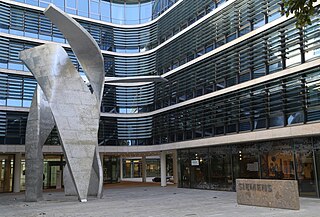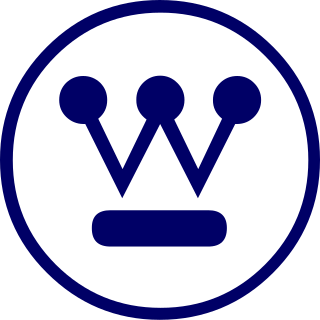Related Research Articles
Vickers was a famous name in British engineering that existed through many companies from 1828 until 1999.

British Aerospace plc (BAe) was a British aircraft, munitions and defence-systems manufacturer. Its head office was at Warwick House in the Farnborough Aerospace Centre in Farnborough, Hampshire. Formed in 1977, in 1999 it purchased Marconi Electronic Systems, the defence electronics and naval shipbuilding subsidiary of the General Electric Company plc, to form BAE Systems.
Marconi Electronic Systems (MES), or GEC-Marconi as it was until 1998, was the defence arm of General Electric Company (GEC). It was demerged from GEC and bought by British Aerospace (BAe) on 30 November 1999 to form BAE Systems. GEC then renamed itself Marconi plc.
The General Electric Company, or GEC, was a major British industrial conglomerate involved in consumer and defence electronics, communications, and engineering. The company was founded in 1886, was Britain's largest private employer with over 250,000 employees in the 1980s, and at its peak in the 1990s, made profits of over £1 billion a year.

Siemens AG is a German multinational conglomerate and a focused technology corporation headquartered in Munich and the largest industrial manufacturing company in Europe with branch offices abroad.
BAE Systems plc (BAE) is a British multinational arms, security, and aerospace company based in London, England. The company is the largest defence contractor in Europe and among the world's largest defence companies; it was ranked as the third-largest based on applicable 2017 revenues. Its largest operations are in the United Kingdom and United States, where its BAE Systems Inc. subsidiary is one of the six largest suppliers to the US Department of Defense. Other major markets include Australia, India, and Saudi Arabia, which account for about 20% of BAE's overall sales. It is the biggest manufacturer in Britain. The company was formed on 30 November 1999 by the £7.7 billion purchase of and merger with Marconi Electronic Systems (MES)—the defence electronics and naval shipbuilding subsidiary of the General Electric Company plc (GEC)—by British Aerospace, an aircraft, munitions and naval systems manufacturer.

The Westinghouse Electric Corporation was an American manufacturing company founded in 1886 by George Westinghouse. It was originally named "Westinghouse Electric & Manufacturing Company", and was renamed "Westinghouse Electric Corporation" in 1945. The company acquired the CBS television network in 1995, and was renamed as the first incarnation of "CBS Corporation", until being acquired by Viacom in 1999. That merger was completed on April 26, 2000.
The Plessey Company plc was a British electronics, defence and telecommunications company. It originated in 1917, growing and diversifying into electronics. It expanded after the Second World War by acquisition of companies and formed overseas companies.
The Marconi Company was a British telecommunications and engineering company that did business under that name from 1963 to 1987. Its roots were in the Wireless Telegraph & Signal Company founded by Italian inventor Guglielmo Marconi in 1897, which underwent several changes in name after mergers and acquisitions. The company was a pioneer of wireless long distance communication and mass media broadcasting, eventually becoming one of the UK's most successful manufacturing companies. In 1999, its defence equipment manufacturing division, Marconi Electronic Systems, merged with British Aerospace (BAe) to form BAE Systems. In 2006, financial difficulties led to the collapse of the remaining company, with the bulk of the business acquired by the Swedish telecommunications company, Ericsson.
Siemens Plessey was the name given to the Plessey assets acquired by Siemens in 1989. Today most of these units are part of BAE Systems while some units are now part of EADS.

Marconi Communications, the former telecommunications arm of Britain's General Electric Company plc (GEC), was founded in August 1998 through the amalgamation of GEC Plessey Telecommunications (GPT) with other GEC subsidiaries: Marconi SpA, GEC Hong Kong, and ATC South Africa.
GEC Plessey Telecommunications (GPT) was a British manufacturer of telecommunications equipment, notably the System X telephone exchange. The company was founded in 1988 as a joint venture between GEC and the British electronics, defence and telecommunications company Plessey. The next year, after a joint holding company of GEC and the German conglomerate Siemens AG acquired Plessey, GPT was converted into a 60/40 GEC/Siemens joint venture. The GPT name ceased to be used in the mid-1990s, and in 1998 the company was amalgamated into Siemens Communications.
BAE Systems Inc. is an American subsidiary of British defense, security, and aerospace company BAE Systems plc. The American subsidiary operates under a Special Security Arrangement which allows it to work on some of the most sensitive United States defense programs despite its foreign ownership. It is incorporated in Delaware. It employs approximately 35,000 workers within U.S. borders and several thousand more in Israel, South Africa, Sweden and the United Kingdom. Major business lines of BAE Systems Inc. include electronic warfare, sensing and communications equipment; armored vehicles, artillery systems; naval guns and naval ship repair; and cybersecurity and intelligence services.
Tracor was a major North American defense electronics contractor which was acquired by Marconi Electronic Systems (MES), a subsidiary of General Electric Company plc, in 1998. Following the purchase of MES by British Aerospace in November 1999 to form BAE Systems, Tracor became BAE Systems Integrated Defense Solutions. Following a 2005 reorganisation, the company became BAE Systems Sensor Integration, part of Electronics and Integrated Solutions.
BAE Systems Platforms & Services is a wholly owned subsidiary of BAE Systems Inc. and is a large provider of tracked and wheeled armored combat vehicles, naval guns, naval ship repair and modernization, artillery and missile launching systems, advanced precision strike munitions and ordnance, and other technologies for U.S. and international customers. It was created on 24 June 2005, following the completion of BAE Systems' acquisition of United Defense in 2004 and its merger with BAE Systems Land Systems. In 2007 BAE Systems acquired Armor Holdings adding to the size of Land & Armaments significantly.
VT Group is a privately held United States defense and services company, with its origins in a former British shipbuilding group, previously known as Vosper Thornycroft. The British part of VT Group was integrated into Babcock International in the early 2010s. In July 2012, The Resolute Fund II, LP, an affiliate of The Jordan Company acquired VT Group.
Vickers plc was the remainder of Vickers-Armstrongs after the nationalisation of three of its four operating groups: aviation, shipbuilding and steel. It was purchased by Rolls-Royce plc in 1999, and the Vickers company name became defunct in 2004.

Hazeltine Corporation was a defense electronics company which is now part of BAE Systems Inc.

Dover Corporation is an American conglomerate manufacturer of industrial products. Founded in 1955 in New York City, Dover is now based in Downers Grove, Illinois, and employs more than 26,000 people worldwide. As of 2014, Dover's business was divided into three segments: Engineered Systems, Fluids, and Refrigeration and Food Equipment. By 2020, there were five segments, with Imaging and Identification and Pumps and Process having been added. Each segment holds operating companies that are run like independent companies. Dover is a constituent of the S&P 500 index and trades on the New York Stock Exchange under "DOV". Dover was ranked 429th in the 2020 Fortune 500. The company relocated its headquarters to Illinois from New York in mid-2010.
Royal Ordnance plc was formed on 2 January 1985 as a public corporation, owning the majority of what until then were the remaining United Kingdom government-owned Royal Ordnance Factories which manufactured explosives, ammunition, small arms including the Lee–Enfield rifle, guns and military vehicles such as tanks. It owned some 16 factories; and employed about 19,000 staff.
References
- ↑ Baker, A. L. (February 1, 1951). "NJ.07-3: Prospectus On Uranium Center Operation" (PDF). Energy.gov. Department of Energy. Retrieved 3 October 2014.
- 1 2 Kepos, Paula, ed. (1995). International directory of company histories. Detroit: St. James Press. p. 10. ISBN 9781558623262 . Retrieved 3 October 2014.
- ↑ "British General Electric to Acquire Tracor". Los Angeles Times. April 22, 1998. Retrieved 3 October 2014.
- ↑ "BAe set to sign A8bn GEC deal with merger". guardian.co.uk. The Guardian. 19 January 1999.
- ↑ BAE Systems Annual Report 1999 22. BAE Systems plc (2000).